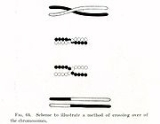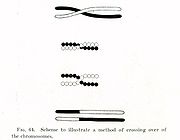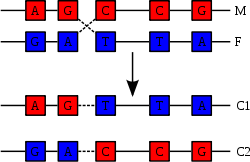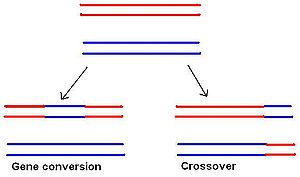
Chromosomal crossover
Encyclopedia



Homologous chromosome
Homologous chromosomes are chromosome pairs of approximately the same length, centromere position, and staining pattern, with genes for the same characteristics at corresponding loci. One homologous chromosome is inherited from the organism's mother; the other from the organism's father...
s. It is one of the final phases of genetic recombination
Genetic recombination
Genetic recombination is a process by which a molecule of nucleic acid is broken and then joined to a different one. Recombination can occur between similar molecules of DNA, as in homologous recombination, or dissimilar molecules, as in non-homologous end joining. Recombination is a common method...
, which occurs during prophase I of meiosis
Meiosis
Meiosis is a special type of cell division necessary for sexual reproduction. The cells produced by meiosis are gametes or spores. The animals' gametes are called sperm and egg cells....
(pachytene) in a process called synapsis
Synapsis
Synapsis is the pairing of two homologous chromosomes that occurs during meiosis. It allows matching-up of homologous pairs prior to their segregation, and possible chromosomal crossover between them. Synapsis takes place during prophase I. When homologous chromosomes synapse, their ends are...
. Synapsis begins before the synaptonemal complex
Synaptonemal complex
The synaptonemal complex is a protein structure that forms between homologous chromosomes during meiosis and that is thought to mediate chromosome pairing, synapsis, and recombination . It is now evident that the synaptonemal complex is not required for genetic recombination...
develops, and is not completed until near the end of prophase I. Crossover usually occurs when matching regions on matching chromosome
Chromosome
A chromosome is an organized structure of DNA and protein found in cells. It is a single piece of coiled DNA containing many genes, regulatory elements and other nucleotide sequences. Chromosomes also contain DNA-bound proteins, which serve to package the DNA and control its functions.Chromosomes...
s break and then reconnect to the other chromosome.
Crossing over was described, in theory, by Thomas Hunt Morgan
Thomas Hunt Morgan
Thomas Hunt Morgan was an American evolutionary biologist, geneticist and embryologist and science author who won the Nobel Prize in Physiology or Medicine in 1933 for discoveries relating the role the chromosome plays in heredity.Morgan received his PhD from Johns Hopkins University in zoology...
. He relied on the discovery of the Belgian Professor Frans Alfons Janssens
Frans Alfons Janssens
Frans Alfons Janssens . Ordained as a priest in 1886. He obtained a PhD in Natural Science with the highest honors and a scholarchip to attend the most prestigious foreign laboratories. He worked with Professor Kjeldahl at the Hansen Institute Carlsberg Brewery in Copenhagen. He was also a teacher...
of the University of Leuven who described the phenomenon in 1909 and had called it 'chiasmatypie'. The term chiasma
Chiasma (genetics)
A chiasma , in genetics, is thought to be the point where two homologous non-sister chromatids exchange genetic material during chromosomal crossover during meiosis...
is linked if not identical to chromosomal crossover. Morgan immediately saw the great importance of Janssens' cytological interpretation of chiasmata to the experimental results of his research on the heredity of Drosophila
Drosophila
Drosophila is a genus of small flies, belonging to the family Drosophilidae, whose members are often called "fruit flies" or more appropriately pomace flies, vinegar flies, or wine flies, a reference to the characteristic of many species to linger around overripe or rotting fruit...
. The physical basis of crossing over was first demonstrated by Harriet Creighton
Harriet Creighton
Harriet Baldwin Creighton was an American botanist, geneticist and educator.Born in Delavan, Illinois, Creighton graduated from Wellesley College in 1929, and went on to complete her Ph.D. at Cornell University in 1933...
and Barbara McClintock
Barbara McClintock
Barbara McClintock , the 1983 Nobel Laureate in Physiology or Medicine, was an American scientist and one of the world's most distinguished cytogeneticists. McClintock received her PhD in botany from Cornell University in 1927, where she was a leader in the development of maize cytogenetics...
in 1931.
Chemistry
Meiotic recombination initiates with double-stranded breaks that are introduced into the DNA by the Spo11SPO11
Spo11 is a protein used in a complex along with Mre11 and Rad50 during meiotic recombination. It is also involved in the creation of double stranded breaks in the DNA in the early stages of this process. Its active site contains a tyrosine which ligates and dissociates with DNA to promote break...
protein. One or more exonucleases
Exonuclease
Exonucleases are enzymes that work by cleaving nucleotides one at a time from the end of a polynucleotide chain. A hydrolyzing reaction that breaks phosphodiester bonds at either the 3’ or the 5’ end occurs. Its close relative is the endonuclease, which cleaves phosphodiester bonds in the middle ...
then digest the 5’ ends generated by the double-stranded breaks to produce 3’ single-stranded DNA tails. The meiosis-specific recombinase Dmc1 and the general recombinase Rad51
RAD51
RAD51 is a human gene. The protein encoded by this gene is a member of the RAD51 protein family which assist in repair of DNA double strand breaks. RAD51 family members are homologous to the bacterial RecA and yeast Rad51...
coat the single-stranded DNA to form nucleoprotein filaments. The recombinases catalyze invasion of the opposite chromatid
Chromatid
A chromatid is one of the two identical copies of DNA making up a duplicated chromosome, which are joined at their centromeres, for the process of cell division . They are called sister chromatids so long as they are joined by the centromeres...
by the single-stranded DNA from one end of the break. Next, the 3’ end of the invading DNA primes DNA synthesis, causing displacement of the complementary strand, which subsequently anneals to the single-stranded DNA generated from the other end of the initial double-stranded break. The structure that results is a cross-strand exchange, also known as a Holliday junction
Holliday junction
A Holliday junction is a mobile junction between four strands of DNA. The structure is named after Robin Holliday, who proposed it in 1964 to account for a particular type of exchange of genetic information he observed in yeast known as homologous recombination...
. The contact between two chromatids that will soon undergo crossing-over is known as a chiasma
Chiasma (genetics)
A chiasma , in genetics, is thought to be the point where two homologous non-sister chromatids exchange genetic material during chromosomal crossover during meiosis...
. The Holliday junction is a tetrahedral
Tetrahedron
In geometry, a tetrahedron is a polyhedron composed of four triangular faces, three of which meet at each vertex. A regular tetrahedron is one in which the four triangles are regular, or "equilateral", and is one of the Platonic solids...
structure which can be 'pulled' by other recombinases, moving it along the four-stranded structure.
Consequences

Eukaryote
A eukaryote is an organism whose cells contain complex structures enclosed within membranes. Eukaryotes may more formally be referred to as the taxon Eukarya or Eukaryota. The defining membrane-bound structure that sets eukaryotic cells apart from prokaryotic cells is the nucleus, or nuclear...
s, a cell
Cell (biology)
The cell is the basic structural and functional unit of all known living organisms. It is the smallest unit of life that is classified as a living thing, and is often called the building block of life. The Alberts text discusses how the "cellular building blocks" move to shape developing embryos....
carries two copies of each gene
Gene
A gene is a molecular unit of heredity of a living organism. It is a name given to some stretches of DNA and RNA that code for a type of protein or for an RNA chain that has a function in the organism. Living beings depend on genes, as they specify all proteins and functional RNA chains...
, each referred to as an allele
Allele
An allele is one of two or more forms of a gene or a genetic locus . "Allel" is an abbreviation of allelomorph. Sometimes, different alleles can result in different observable phenotypic traits, such as different pigmentation...
. Each parent passes on one allele to each offspring. An individual gamete
Gamete
A gamete is a cell that fuses with another cell during fertilization in organisms that reproduce sexually...
inherits a complete haploid complement of alleles on chromosomes that are independently selected from each pair of chromatids
Chromatid
A chromatid is one of the two identical copies of DNA making up a duplicated chromosome, which are joined at their centromeres, for the process of cell division . They are called sister chromatids so long as they are joined by the centromeres...
lined up on the metaphase plate. Without recombination, all alleles for those genes linked together on the same chromosome would be inherited together. Meiotic recombination allows a more independent selection between the two alleles that occupy the positions of single genes, as recombination shuffles the allele content between homologous chromosomes.
Recombination results in a new arrangement of maternal and paternal alleles on the same chromosome. Although the same genes appear in the same order, the alleles are different. In this way, it is theoretically possible to have any combination of parental alleles in an offspring, and the fact that two alleles appear together in one offspring does not have any influence on the statistical probability that another offspring will have the same combination. This theory of "independent assortment
Mendelian inheritance
Mendelian inheritance is a scientific description of how hereditary characteristics are passed from parent organisms to their offspring; it underlies much of genetics...
" of alleles is fundamental to genetic inheritance.
However, the frequency of recombination is actually not the same for all gene combinations. This leads to the notion of "genetic distance
Centimorgan
In genetics, a centimorgan or map unit is a unit of recombinant frequency for measuring genetic linkage, defined as that distance between chromosome positions for which the expected average number of intervening chromosomal crossovers in a single generation is 0.01. It is often used to infer...
", which is a measure of recombination frequency averaged over a (suitably large) sample of pedigrees. Loosely speaking, one may say that this is because recombination is greatly influenced by the proximity of one gene to another. If two genes are located close together on a chromosome, the likelihood that a recombination event will separate these two genes is less than if they were farther apart. Genetic linkage
Genetic linkage
Genetic linkage is the tendency of certain loci or alleles to be inherited together. Genetic loci that are physically close to one another on the same chromosome tend to stay together during meiosis, and are thus genetically linked.-Background:...
describes the tendency of genes to be inherited together as a result of their location on the same chromosome. Linkage disequilibrium
Linkage disequilibrium
In population genetics, linkage disequilibrium is the non-random association of alleles at two or more loci, not necessarily on the same chromosome. It is also referred to as to as gametic phase disequilibrium , or simply gametic disequilibrium...
describes a situation in which some combinations of genes or genetic markers occur more or less frequently in a population than would be expected from their distances apart. This concept is applied when searching for a gene that may cause a particular disease
Disease
A disease is an abnormal condition affecting the body of an organism. It is often construed to be a medical condition associated with specific symptoms and signs. It may be caused by external factors, such as infectious disease, or it may be caused by internal dysfunctions, such as autoimmune...
. This is done by comparing the occurrence of a specific DNA sequence
DNA sequence
The sequence or primary structure of a nucleic acid is the composition of atoms that make up the nucleic acid and the chemical bonds that bond those atoms. Because nucleic acids, such as DNA and RNA, are unbranched polymers, this specification is equivalent to specifying the sequence of...
with the appearance of a disease. When a high correlation between the two is found, it is likely that the appropriate gene sequence is really closer.
Problems
Although crossovers typically occur between homologous regions of matching chromosomes, similarities in sequence can result in mismatched alignments. These processes are called unbalanced recombination. Unbalanced recombination is fairly rare compared to normal recombination, but severe problems can arise if a gamete containing unbalanced recombinants becomes part of a zygoteZygote
A zygote , or zygocyte, is the initial cell formed when two gamete cells are joined by means of sexual reproduction. In multicellular organisms, it is the earliest developmental stage of the embryo...
. The result can be a local duplication
Gene duplication
Gene duplication is any duplication of a region of DNA that contains a gene; it may occur as an error in homologous recombination, a retrotransposition event, or duplication of an entire chromosome.The second copy of the gene is often free from selective pressure — that is, mutations of it have no...
of genes on one chromosome and a deletion of these on the other, a translocation
Chromosomal translocation
In genetics, a chromosome translocation is a chromosome abnormality caused by rearrangement of parts between nonhomologous chromosomes. A gene fusion may be created when the translocation joins two otherwise separated genes, the occurrence of which is common in cancer. It is detected on...
of part of one chromosome onto a different one, or an inversion
Chromosomal inversion
An inversion is a chromosome rearrangement in which a segment of a chromosome is reversed end to end. An inversion occurs when a single chromosome undergoes breakage and rearrangement within itself. Inversions are of two types: paracentric and pericentric.Paracentric inversions do not include the...
.
See also
- Unequal crossing overUnequal crossing overUnequal crossing over is a type of gene duplication event that deletes a sequence in one strand and replaces it with a duplication from its sister chromatid in mitosis or from its homologous chromosome during meiosis. It is a type of chromosomal crossover between homologous sequences that are not...
- Coefficient of coincidenceCoefficient of coincidenceIn genetics, the coefficient of coincidence is a measure of interference in the formation of chromosomal crossovers during meiosis. It is generally the case that, if there is a crossover at one spot on a chromosome, this decreases the likelihood of a crossover in a nearby spot...
- Genetic distanceGenetic distanceGenetic distance refers to the genetic divergence between species or between populations within a species. It is measured by a variety of parameters. Smaller genetic distances indicate a close genetic relationship whereas large genetic distances indicate a more distant genetic relationship...
- Independent assortment
- Mitotic crossoverMitotic crossoverMitotic crossover is a rare type of genetic recombination that may occur in some types of somatic cells during mitosis. Mitotic crossover may occur in organisms that do not have a cycle of sexual reproduction where chromosomal crossover would normally occur during meiosis to generate genetic...
- Recombinant frequency

